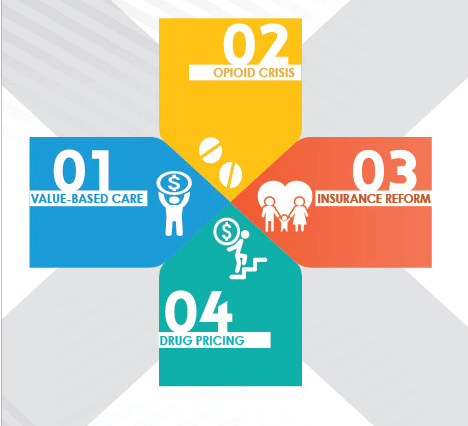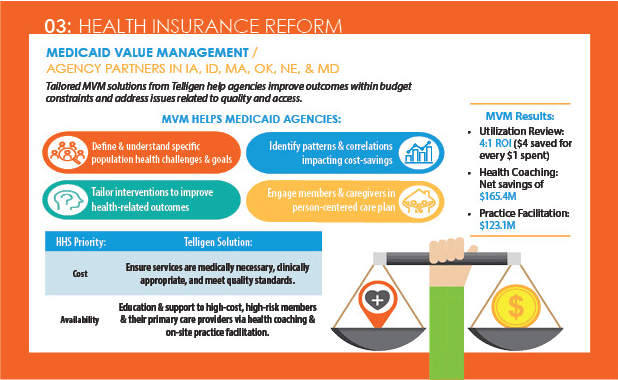So much of what drives expensive, chronic health conditions are often called social determinants of health… For millions of Americans, our lives outside the doctor’s office can have major impacts on health outcomes.
— Alex Azar, Remarks to America’s Essential Hospitals 12/11/18

Emergency room visits and hospital stays from accidents and infection are expensive, but they pale in comparison to the cost of caring for chronic conditions. According to the Centers for Disease Control and Prevention, the country spends 86 percent of its healthcare dollars, or $2.3 trillion annually, on chronic disease and mental healthcare.
One way to improve the odds for these patients is to increase access to services, like necessary medications or periodic medical tests, that prevent the progression of, or complications from, chronic conditions.
Priority #3: Making Insurance Accessible and Affordable
In order to make healthcare more accessible, we need to make it more affordable. The Department of Health and Human Services is doing this by transforming our healthcare system into one that pays for value; in addition to meeting other priorities related to the opioid crisis and lowering the cost of prescription drugs.
In 2018, Telligen helped Medicaid agencies — Iowa, Indiana, Massachusetts, Oklahoma, Nebraska, and Maryland — improve the availability and affordability of health insurance through utilization review, case management, and practice facilitation services. Specifically, Telligen’s services have helped Oklahoma save taxpayers $106.6 million over the last four-years, with a return on investment of 288 percent.
“This program is not just saving money; it’s about finding innovative ways to help Medicaid members eliminate barriers to care and improve their health,” said DJ Jones, Telligen’s HMP Director. “By engaging both members and physicians we have a better chance of improving outcomes, delivering value and lowering costs.”

Better Health and Lower Costs for Members with Chronic Conditions
Now in its tenth year administering the program, Telligen uses analytics to identify members who are high-risk or at-risk for developing chronic conditions — from heart disease, to asthma, to diabetes. Identified members and their primary care providers then receive increased and support through personalized health coaching and on-site practice facilitation.
Personalized Health Coaching
Nurse coaches, embedded within primary care practices, provide members with one-on-one health coaching, telephone support, and home visits. So far, the health coaching component demonstrated a net savings of $165.4 million.
Onsite Practice Facilitation
On-site practice facilitators work directly with Oklahoma providers to redesign clinical processes and eliminate gaps in care. An increased compliance with evidence-based guidelines has saved the state an additional $123.1 million.
The Result
The total results over the last ten years show a taxpayer savings of more than $288.5 million. In addition, results from an independent evaluation report 90 percent of members were “very satisfied” with their experience.
“This program represents a major change in the way state Medicaid programs are delivering care,” says Jeff Chungath, Telligen CEO. “Oklahoma is taking an active role in ensuring members are receiving the preventative care and education necessary to manage their conditions. The end result is a reduction in avoidable complications and costly hospital visits.”

